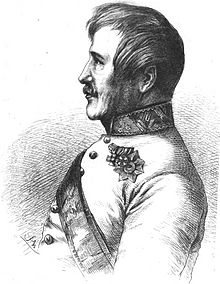Ferdinand (Hessen-Homburg)
Ferdinand Heinrich Friedrich (born April 26, 1783 in Homburg before the height ; † March 24, 1866 there ) was the last ruling Landgrave of Hesse-Homburg .
Life
Youth and military
He was the fifth son of Landgrave Friedrich V and his wife Karoline von Hessen-Darmstadt , a daughter of Landgrave Ludwig IX. von Hessen-Darmstadt and Henriette Karoline von Pfalz-Zweibrücken , the great countess .
In 1800, at the age of 17, he joined the Austrian cuirassier regiment "Karl von Lothringen". According to contemporary reports, he was "the ideal figure of an armored rider." He was to be found on all the battlefields of the Napoleonic Wars and was severely wounded several times. After the Battle of the Nations near Leipzig , Emperor Franz awarded him the highest distinction in the Austrian army, the Maria Theresa Order . In 1822 he retired from active military service with the rank of general of the cavalry (Feldzeugmeister).
Governing Landgrave of Hesse-Homburg

On September 8, 1848, after the death of his brother, Landgrave Gustav, he took office. At this point it was already clear that he would be the last Landgrave of Homburg, as his nephew Friedrich had died a few months earlier and Ferdinand was the last male representative of the line. Ferdinand, who never married, has only lived in a few attic rooms in the orangery in the Homburg palace garden together with his personal hunter since he took office . Even contemporaries referred to him as "shy of women". Mainly he devoted himself to his passions, hunting and studying the Roman-Germanic period of the Taunus . With the iron thrift that he himself exemplified, guilt after guilt was repaid in order to get the shattered finances of Hessen-Homburg under control. The casino of the brothers François and Louis Blanc , which was still licensed under his brother, Landgrave Philipp, contributed a large part . The revolution of 1848 did not stop at the small Hesse-Homburg and so Ferdinand called a constituent parliament in April 1849 at the request of the state and accepted the Hesse-Homburg constitution given by his predecessor, Landgrave Gustav . After the end of the German National Assembly , he repealed this constitution on April 20, 1852 by a landgrave decree and ruled his country as a sovereign landgrave until his death - loved by his country children. In September 1850 he was among the first princes to send to the restored Bundestag .
Death and succession
He died on March 24, 1866 in the eighty-third year of life without any descendants, whereupon Hessen-Homburg - according to the inheritance contract - fell to Hessen-Darmstadt , but after the war of 1866 to Prussia . He was buried in the crypt of Bad Homburg Castle and thus filled the supposedly last free space.
literature
- Jaromir Hirtenfeld : The Military Maria Theresa Order and its members , Vienna 1857, pp. 1222-1223
- Constantin von Wurzbach : Hessen-Homburg, Ferdinand Heinrich . In: Biographisches Lexikon des Kaiserthums Oesterreich . 8th part. Kaiserlich-Königliche Hof- und Staatsdruckerei, Vienna 1862, pp. 434–436 ( digitized version ).
- Walther: Ferdinand . In: Allgemeine Deutsche Biographie (ADB). Volume 6, Duncker & Humblot, Leipzig 1877, p. 690 f.
- Karl Schwartz: Landgrave Friedrich V of Hessen-Homburg and his family. From archival documents and family papers, Rudolstadt 1878
- Hessen-Homburg Ferdinand Heinrich Landgf. from. In: Austrian Biographical Lexicon 1815–1950 (ÖBL). Volume 2, Verlag der Österreichischen Akademie der Wissenschaften, Vienna 1959, p. 305.
Web links
- Hessen-Homburg, Ferdinand Heinrich Friedrich Prince of. Hessian biography. (As of February 3, 2020). In: Landesgeschichtliches Informationssystem Hessen (LAGIS).
Individual evidence
- ↑ Julius Eberberg: Household, Court and State Stories: From past few days, volume 1. Prague 1869, page 36ff
| predecessor | Office | successor |
|---|---|---|
| Gustav |
Landgrave of Hessen-Homburg 1848–1866 |
Grand Duke Ludwig III. from Hessen-Darmstadt |
| personal data | |
|---|---|
| SURNAME | Ferdinand |
| ALTERNATIVE NAMES | Ferdinand Heinrich Friedrich |
| BRIEF DESCRIPTION | Landgrave of Hessen-Homburg, Austrian general of the cavalry |
| DATE OF BIRTH | April 26, 1783 |
| PLACE OF BIRTH | Homburg vor der Höhe |
| DATE OF DEATH | March 24, 1866 |
| Place of death | Homburg vor der Höhe |
